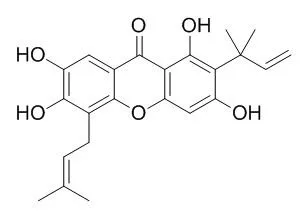| In vitro: |
| J Nat Prod. 2007 Jul;70(7):1207-9. | | Prenylated xanthones from the root bark of Cudrania tricuspidata.[Pubmed: 17608532] |
METHODS AND RESULTS:
Four new prenylated xanthones, cudratricusxanthones J-M (1-4), were isolated from the CH2Cl2-soluble extract of the root bark of Cudrania tricuspidata, along with four known prenylated xanthones, isocudraxanthone K (5), cudraxanthone C (6), cudratricusxanthone A (7), and Cudraxanthone L (8), and three known prenylated flavonoids, cudraflavone A (9), cudraflavanone A (10), and cudraflavone B (11).
CONCLUSIONS:
The structures of compounds 1-4 were elucidated using spectroscopic methods. Cudratricusxanthone A (7), cudraflavanone A (10), and cudraflavone B (11) showed moderate inhibitory effects on mouse brain monoamine oxidase (MAO) with IC50 values of 88.3, 89.7, and 80.0 microM, respectively. | | Arch Pharm Res. 2005 Jan;28(1):44-8. | | Hepatoprotective constituents of Cudrania tricuspidata.[Pubmed: 15742807] |
METHODS AND RESULTS:
Phytochemical investigation of the MeOH extract of the root barks of Cudrania tricuspidata Bureau (Moraceae), as guided by hepatoprotective activity in vitro, furnished four isoprenylated xanthones, cudratricusxanthone A (1), Cudraxanthone L (2), cudratricusxanthone E (3), and macluraxanthone B (4).
CONCLUSIONS:
All of these compounds showed the significant hepatoprotective effect on tacrine-induced cytotoxicity in human liver-derived Hep G2 cells. Compounds 1, 2, and 4 also exhibited the significant hepatoprotective effect on nitrofurantoin-induced cytotoxicity in human liver-derived Hep G2 cells. |
|






 Cell. 2018 Jan 11;172(1-2):249-261.e12. doi: 10.1016/j.cell.2017.12.019.IF=36.216(2019)
Cell. 2018 Jan 11;172(1-2):249-261.e12. doi: 10.1016/j.cell.2017.12.019.IF=36.216(2019) Cell Metab. 2020 Mar 3;31(3):534-548.e5. doi: 10.1016/j.cmet.2020.01.002.IF=22.415(2019)
Cell Metab. 2020 Mar 3;31(3):534-548.e5. doi: 10.1016/j.cmet.2020.01.002.IF=22.415(2019) Mol Cell. 2017 Nov 16;68(4):673-685.e6. doi: 10.1016/j.molcel.2017.10.022.IF=14.548(2019)
Mol Cell. 2017 Nov 16;68(4):673-685.e6. doi: 10.1016/j.molcel.2017.10.022.IF=14.548(2019)